
Concept explainers
(a)
Interpretation:
The Lewis formula of
Concept Introduction:
Lewis Structure: A Lewis structure shows a covalent bond as pair of electrons shared between two atoms.
Procedure to write Lewis formulas:
- 1) The symbols of the atoms that are bonded together in the molecule next to one another are arranged.
- 2) The total number of valence electrons in the molecule is calculated by adding the number of valence electrons for all the atoms in the molecules. If the species is an ion, then the charge of ion into account by adding electrons, if it is a negative ion or subtracting electrons if it is a positive ion.
- 3) A two-electron covalent bond is represented by placing a line between the atoms, which are assumed to be bonded to each other.
- 4) The remaining valence electrons as lone pairs about each atom are arranged so that the octet rule is satisfied for each other.
Formal charge (F.C): The charges that assigned to each atom in a molecule or ion by a set of arbitrary rules and don not actually represent the actual charges on the atoms are called as formal charges.
The formal charge is calculated using the formula,
The Lewis structure with zero formal charge or least separated formal charges is the preferred structure of the molecule.
(a)
Explanation of Solution
The total number of valence electrons in
Number of valence electrons in hydrogen=
Number of valence electrons in oxygen=
Number of valence electrons in sulphur=
The total number of valence electrons is thirty-two.
One sulphur atom forms four bonds oxygen and two oxygen forms a bond with hydrogen atoms that means twelve electrons are used to form that bonds and remaining twenty electrons are used to satisfy the octet rule of atoms.
The Lewis formula is,
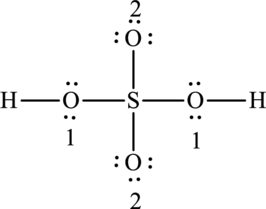
The formal charge for each atom is calculated as,
Formal charge on sulphur=
Formula charge on oxygen (1)=
Formula charge on oxygen (2)=
Formula charge on hydrogen=
The Lewis formula is,
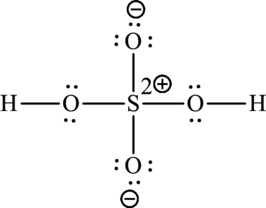
A large charge separation can be seen in the structure, this can be avoided by adding two pi bonds between oxygen and sulphur. The sulphur atom can expand the octet rule since it belongs to period three. The final Lewis structure is,
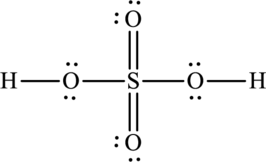
(b)
Interpretation:
The Lewis formula of
Concept Introduction:
Refer to part (a).
(b)
Explanation of Solution
The total number of valence electrons in
Number of valence electrons in hydrogen=
Number of valence electrons in oxygen=
Number of valence electrons in sulphur=
The total number of valence electrons is thirty-two.
One sulphur atom forms one bond with other sulphur atom and three bonds oxygen and two oxygen forms a bond with hydrogen atoms that means twelve electrons are used to form that bonds and remaining twenty electrons are used to satisfy the octet rule of atoms.
The Lewis formula is,
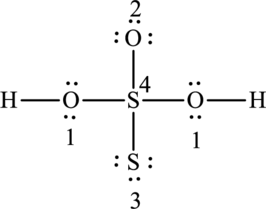
The formal charge for each atom is calculated as,
Formal charge on sulphur (3)=
Formal charge on sulphur (4)=
Formula charge on oxygen (1)=
Formula charge on oxygen (2)=
Formula charge on hydrogen=
The Lewis formula is,
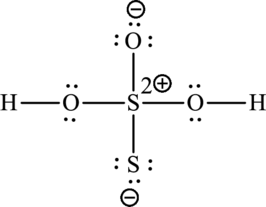
A large charge separation can be seen in the structure, this can be avoided by adding two pi bonds between oxygen and sulphur. The sulphur atom can expand the octet rule since it belongs to period three. The final Lewis structure is,
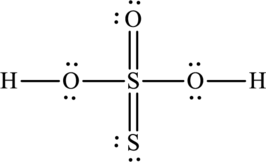
(c)
Interpretation:
The Lewis formula of
Concept Introduction:
Refer to part (a).
(c)
Explanation of Solution
The total number of valence electrons in
Number of valence electrons in hydrogen=
Number of valence electrons in oxygen=
Number of valence electrons in sulphur=
The total number of valence electrons is fifty-six.
One
The Lewis formula is,
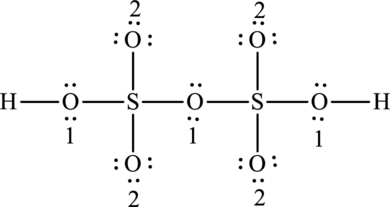
The formal charge for each atom is calculated as,
Formal charge on sulphur=
Formula charge on oxygen (1)=
Formula charge on oxygen (2)=
Formula charge on hydrogen=
The Lewis formula is,
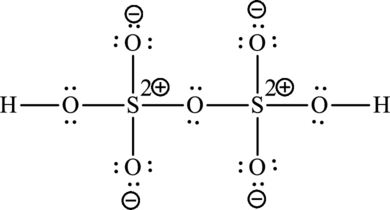
A large charge separation can be seen in the structure, this can be avoided by adding four pi bonds between oxygen and sulphur. The sulphur atom can expand the octet rule since it belongs to period three. The final Lewis structure is,
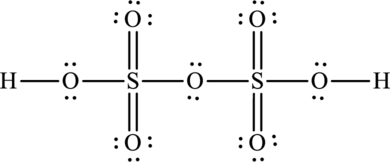
(d)
Interpretation:
The Lewis formula of
Concept Introduction:
Refer to part (a).
(d)
Explanation of Solution
The total number of valence electrons in
Number of valence electrons in hydrogen=
Number of valence electrons in oxygen=
Number of valence electrons in sulphur=
The total number of valence electrons is fifty.
One S-S bonds is formed. One sulphur atom forms one bond with other sulphur. Each of two sulphur atom forms another three bonds with oxygen atoms and two oxygen atoms form a bond with hydrogen atom that means eighteen electrons form that bonds and the remaining thirty-two are used to satisfy the octet rule of atoms.
The Lewis formula is,
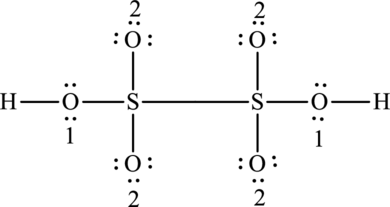
The formal charge for each atom is calculated as,
Formal charge on sulphur=
Formula charge on oxygen (1)=
Formula charge on oxygen (2)=
Formula charge on hydrogen=
The Lewis formula is,
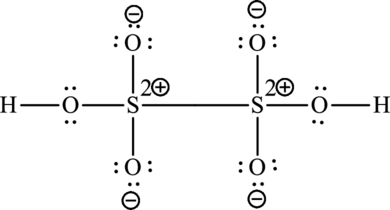
A large charge separation can be seen in the structure, this can be avoided by adding four pi bonds between oxygen and sulphur. The sulphur atom can expand the octet rule since it belongs to period three. The final Lewis structure is,
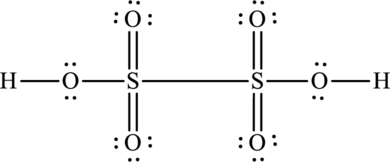
(e)
Interpretation:
The Lewis formula of
Concept Introduction:
Refer to part (a).
(e)
Explanation of Solution
The total number of valence electrons in
Number of valence electrons in hydrogen=
Number of valence electrons in oxygen=
Number of valence electrons in sulphur=
The total number of valence electrons is sixty-two.
One O-O bond is formed from one oxygen atoms that forms one bond with other oxygen atom. Each of the oxygen atom forms one bond with one sulphur tom. Each of two sulphur forms another three bonds with oxygen atoms and two oxygen atoms form two bonds with hydrogen atom that means twenty-two electrons form that bonds and the remaining forty are used to satisfy the octet rule of atoms.
The Lewis formula is,
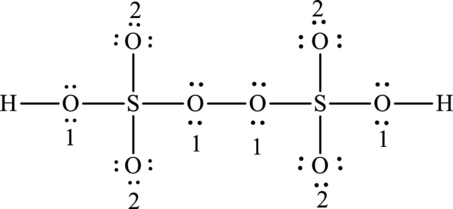
The formal charge for each atom is calculated as,
Formal charge on sulphur=
Formula charge on oxygen (1)=
Formula charge on oxygen (2)=
Formula charge on hydrogen=
The Lewis formula is,
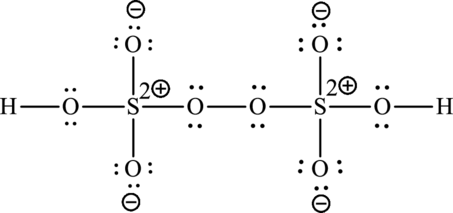
A large charge separation can be seen in the structure, this can be avoided by adding four pi bonds between oxygen and sulphur. The sulphur atom can expand the octet rule since it belongs to period three. The final Lewis structure is,
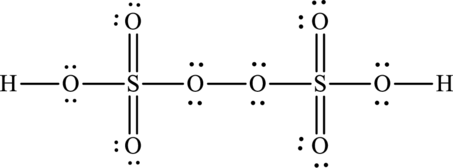
Want to see more full solutions like this?
Chapter 7 Solutions
GENERAL CHEMISTRY ACHIEVE ACCESS W/BOOK
- Can you explain how I get these here and show the steps plz?arrow_forwardGive the IUPAC name for this compound Hydrocarbon Condensed Formulas Hint C2H5 CH2CH3 expand that in all the formula Part A: (CH3)2CHCH(C2H5)CH2CH2CH3 Give the IUPAC name for this compound. Part B: CH2=C(C2H5)CH2CH2CH3 Give the IUPAC name for this compound. Part C: (CH3)2C=CHC(C2H5)=CH2 Give the IUPAC name for this compound. Part D: CH3C=CCH(C2H5)2 Give the IUPAC name for this compound. Part E: (CH3)3CC=CCH2CH=C(CH3)2arrow_forwardSelect/ Match the correct letter from the image below for the IUPAC names given below: A B C D 3 E F G H K L Part 1. 4-methylheptane For example.mmmm Answer Letter H _for part 1 Part 2. 2,4-dimethylhexane Part 3. 2,3-dimethylpentane Part 4. 2,2-dimethylhexane Part 5. 2-ethyl-1,1,3,3-tetramethylcyclopentane Part 6. 3-ethyl-2-methylpentanearrow_forward
- Can u show the process as to how to get these?arrow_forwardSketch the expected 'H NMR spectra for the following compound. Label all of the H's in the structure and the corresponding signal for the spectra you sketch. Make sure you include the integration value and the splitting pattern for each signal Indicate how many signals you would expect in the 13C NMRarrow_forwardUse IUPAC naming rules to name the following hydrocarbon compounds: CH2-CH3 | a) CH-CH-CH2-CH-CH-CH3 b) | CH2 CH3 | CH3 CH3 \ / C=C H 1 H CH2-CH3 c) d) CH=C-CH3 e) CH3-CH2-CH2-CH=CH-CH3 f) CH2=CH-CH2-CH=CH-CH3 g) CH3-CH2-C = C-CH2-CH3 h)arrow_forward
- Q5 Name the following : a. b. C. d. e.arrow_forward25. Predict the major product of the following reaction. 1 equivalent of each of the starting materials was used. H₂C CH3 CH3 H3C H3C H3C. CH2 + H3C. heat CH3 CH H.C. CH3 H.C H.C CH3 CH CH3 CH3 A B C Earrow_forwardFind chemical structures based on the below information. a) Chemical formula C6H8O Compound is aromatic plus has two 1H NMR peaks that integrated for 3 each that are singlets (it could have more peaks in the 1H NMR b) Chemical Formula: C6H100 Compounds is conjugated 'H NMR has a signal that integrates for 6 and is a doublet IR spectra has a signal at 1730 cm-1arrow_forward
- Jaslev Propose a synthesis of the following starting from benzene and any other reagents and chemicals. No mechanisms are required. Indicate the condition for each step plus the major product for each step. More than two steps are required. Step 1 Step 2 مہد Brarrow_forwardPart C: The line formula for another branched alkane is shown below. i. In the IUPAC system what is the root or base name of this compound? ii. How many alkyl substituents are attached to the longest chain? iii. Give the IUPAC name for this compound.arrow_forwardPart D: Draw the Structural Formula for 4-ethyl-2-methylhexane Part E. Draw the Structural Formula for 1-chloro-3,3-diethylpentane (Chloro = Cl)arrow_forward
 ChemistryChemistryISBN:9781305957404Author:Steven S. Zumdahl, Susan A. Zumdahl, Donald J. DeCostePublisher:Cengage Learning
ChemistryChemistryISBN:9781305957404Author:Steven S. Zumdahl, Susan A. Zumdahl, Donald J. DeCostePublisher:Cengage Learning ChemistryChemistryISBN:9781259911156Author:Raymond Chang Dr., Jason Overby ProfessorPublisher:McGraw-Hill Education
ChemistryChemistryISBN:9781259911156Author:Raymond Chang Dr., Jason Overby ProfessorPublisher:McGraw-Hill Education Principles of Instrumental AnalysisChemistryISBN:9781305577213Author:Douglas A. Skoog, F. James Holler, Stanley R. CrouchPublisher:Cengage Learning
Principles of Instrumental AnalysisChemistryISBN:9781305577213Author:Douglas A. Skoog, F. James Holler, Stanley R. CrouchPublisher:Cengage Learning Organic ChemistryChemistryISBN:9780078021558Author:Janice Gorzynski Smith Dr.Publisher:McGraw-Hill Education
Organic ChemistryChemistryISBN:9780078021558Author:Janice Gorzynski Smith Dr.Publisher:McGraw-Hill Education Chemistry: Principles and ReactionsChemistryISBN:9781305079373Author:William L. Masterton, Cecile N. HurleyPublisher:Cengage Learning
Chemistry: Principles and ReactionsChemistryISBN:9781305079373Author:William L. Masterton, Cecile N. HurleyPublisher:Cengage Learning Elementary Principles of Chemical Processes, Bind...ChemistryISBN:9781118431221Author:Richard M. Felder, Ronald W. Rousseau, Lisa G. BullardPublisher:WILEY
Elementary Principles of Chemical Processes, Bind...ChemistryISBN:9781118431221Author:Richard M. Felder, Ronald W. Rousseau, Lisa G. BullardPublisher:WILEY





